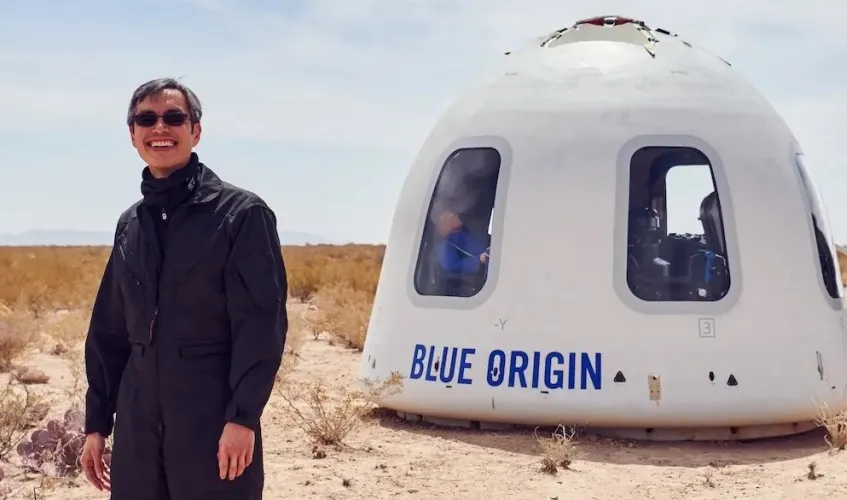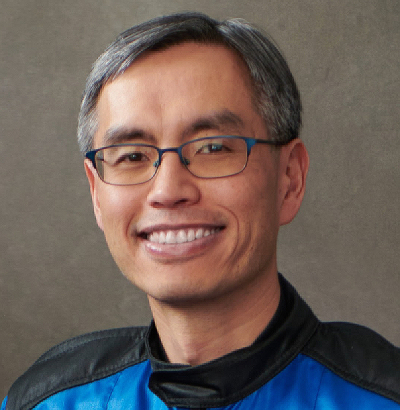Amy Sprague
April 29, 2025
Gary Lai (B.S. '99), who has redefined commercial spaceflight and now aims to harness lunar resources for humanity's future, is our 2025 Distinguished Alumni Award recipient.

Listen to this story:

Gary Lai
From campus to cosmos
When Gary Lai arrived at the University of Washington in the late 1990s, his path to aerospace was anything but traditional. Born in Hong Kong and raised in New York City, Lai had a childhood fascination with space but lacked a clear path to pursue it. "I didn't know any engineers or even what engineering really was while I was growing up," Lai recalls. "It was never discussed as a choice in school, and no one I knew in my high school went into engineering."
His journey took an unexpected turn when his girlfriend Natalya (now his wife of 25 years) accepted an offer to the UW's graduate program in Molecular Biology. Having just realized at Cornell that his true calling was aerospace engineering—not the finance degree he was pursuing—Lai made the bold decision to start over at UW. "I moved here before I was accepted, to work and establish state residency and apply," he shares. "I fell instantly in love with Seattle. The department gave me a full tuition scholarship."
Timing proved fortuitous. The late 1990s marked a pivotal moment in aerospace history, with Seattle at the epicenter of a burgeoning commercial space industry. "NASA was pivoting from the Space Shuttle to develop reusable launch vehicles and turning to industry for assistance. The first true commercial entrepreneurial space ventures were being launched," Lai notes, referencing the formation of pioneering companies like Iridium, Globalstar, Kistler Aerospace, SpaceX, and Blue Origin.
A key connection formed when Professor Adam Bruckner recommended Lai for an internship at Kistler Aerospace, setting his career trajectory. "Kistler was the last job interview I've ever had," Lai says. "Every other position in my career since has been through the network I built from that first position."
"I was involved with the New Shepard program from its inception through flying customers, and was responsible for every aspect of its design and certification, so it was the thrill of my lifetime to be invited to fly on it myself."
Engineering reusable spacecraft
After graduating in 1999, Lai joined Blue Origin as just its 18th employee. What followed was a remarkable 20-year journey from systems engineer to chief architect, where he would lead the development of technologies that have fundamentally changed humanity's relationship with space.
"Gary's career trajectory shows exactly what we hope for our graduates — the technical excellence, leadership skills, and innovative thinking that can transform an industry," says A&A Professor and Chair Kristi Morgansen. "His work has opened the frontier of space to new possibilities."
At Blue Origin, Lai became the chief architect for New Shepard, the reusable suborbital launch vehicle that has made commercial space tourism a reality. His leadership of the New Shepard technical team led to an unprecedented achievement: five successful launches and landings of the same booster within a single year, earning him the prestigious Stellar Award from the RNASA Foundation.
His contributions were further recognized when the Blue Origin New Shepard team received the 2016 Collier Trophy and Lai himself won the Museum of Flight's Pathfinder Award in 2023. But perhaps the most profound validation came in 2022, when Lai himself boarded New Shepard as a crew member, experiencing firsthand the journey to space aboard the very vehicle he had helped create.
"I was involved with the New Shepard program from its inception through flying customers, and was responsible for every aspect of its design and certification, so it was the thrill of my lifetime to be invited to fly on it myself," Lai recalls. The experience proved more overwhelming than he'd anticipated: "I thought I would spend my flight carefully observing and comparing my experience with our design intent. That plan went completely out the window once those engines lit."
The journey transformed his perspective: "It was the most intense experience of my life, so intense that I did not have an intelligent thought in my head until we were back on the ground. Instead, I was fully present, maybe for the first time. The experience taught me many things about myself, to be more present in my daily life, that living more fully is better than living safely."
Lunar ambitions
Today, Lai continues to push boundaries as co-founder and chief technology officer of Interlune, an innovative startup focused on harvesting lunar resources for Earth applications. Working alongside co-founders Rob Meyerson and Harrison Schmitt, Lai is developing sustainable methods for utilizing lunar resources—work that could fundamentally transform humanity's relationship with space while addressing resource challenges here on Earth.
"I think we are living through the start of the third major transformation in the space industry," Lai explains. "The first, which launched the Space Age, was spurred by the Cold War and involved giant government projects and cost-plus contracts to large industrial giants. The second has been a gradual transition away from massive government-led development to public-private partnerships with co-investment from industry."
Now, he sees a new era emerging: "The third that we are now living through is driven primarily by commercial investment and innovative entrepreneurs with the government involved only as customers or regulators." This shift has created unprecedented opportunities: "Launch costs have dropped by a factor of ten since I started my career and are still dropping. It is now realistic for a small team of brilliant engineers to start the next great space company from their dorm rooms or garages."
His focus on lunar resources reflects a visionary perspective on humanity's future: "Harnessing the effectively infinite abundance of space resources for preserving and improving the quality of life on Earth is what I am most excited about."
A Husky at heart
When asked what prepared him for such pioneering work, Lai credits the project-based learning at the UW: "The department coursework provides a fundamental grounding, but it was the project-based work, especially capstone in senior year, that best prepared me for my career."
He recalls working on UW Dawgstar, the University's first student satellite project: "We approached it the way industry would, by having a program management and systems engineering organization setting top-down requirements and decomposing them to subsystem teams. Exposure to this relatively large, ambitious, and well-organized multi-disciplinary project was the perfect foundation to go into industry."
For students hoping to follow in his footsteps, Lai emphasizes the importance of both technical depth and breadth: "While it's important aerospace engineering students get technical depth in one or more areas of their interest, it's also important to get technical breadth and to develop the so-called soft skills. Aerospace engineering is, by its nature, a multidisciplinary field."
He sees systems integration as the key to future-proofing aerospace careers: "The aerospace engineers that become the most impactful leaders are systems engineers, integrating the work of specialized teams into a single, complex product. While A.I. tools are already getting really good at replacing detailed engineering work in narrow fields, I believe it will be a very long time, if ever, before they can meaningfully replace knowledgeable and talented humans doing multidisciplinary systems integration."
Honoring excellence
The A&A Distinguished Alumni Award recognizes graduates who have made substantial contributions to aerospace engineering while demonstrating intellectual curiosity, exploration, integrity, and service. Lai exemplifies these qualities through his technical innovations, leadership in the aerospace community, and ongoing commitment to mentoring the next generation.
He will receive his award at the 2025 A&A Graduation ceremony, where he will serve as the keynote speaker, sharing his insights and inspiration with a new generation of aerospace engineers poised to make their own mark on the future of flight.